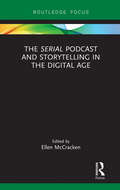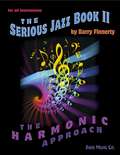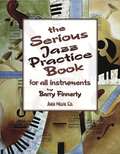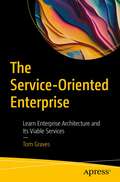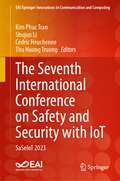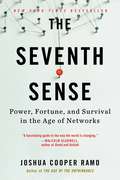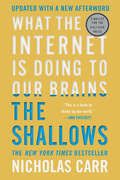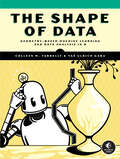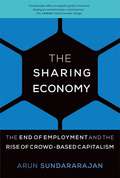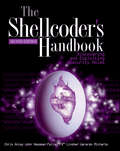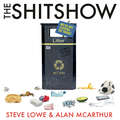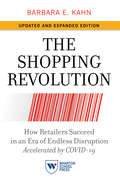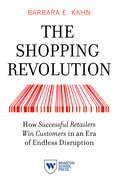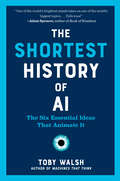- Table View
- List View
The SenticNet Sentiment Lexicon: Exploring Semantic Richness in Multi-Word Concepts
by Raoul BiagioniThe research and its outcomes presented in this book, is about lexicon-based sentiment analysis. It uses single-, and multi-word concepts from the SenticNet sentiment lexicon as the source of sentiment information for the purpose of sentiment classification. In 6 chapters the book sheds light on the comparison of sentiment classification accuracy between single-word and multi-word concepts, for which a bespoke sentiment analysis system developed by the author was used. This book will be of interest to students, educators and researchers in the field of Sentic Computing.
The Sentient Machine: The Coming Age of Artificial Intelligence
by Amir Husain&“A must-read for anyone looking to understand how artificial intelligence is poised to transform human society and life.&” —Paul Scharre, Author of Four Battlegrounds: Power in the Age of Artificial Intelligence The future is now. Acclaimed technologist and inventor Amir Husain explains how we can live amidst the coming age of sentient machines and artificial intelligence—and not only survive, but thrive.Artificial &“machine&” intelligence is playing an ever-greater role in our society. We are already using cruise control in our cars, automatic checkout at the drugstore, and are unable to live without our smartphones. The discussion around AI is polarized; people think either machines will solve all problems for everyone, or they will lead us down a dark, dystopian path into total human irrelevance. Regardless of what you believe, the idea that we might bring forth intelligent creation can be intrinsically frightening. But what if our greatest role as humans so far is that of creators? Amir Husain, a brilliant inventor and computer scientist, argues that we are on the cusp of writing our next, and greatest, creation myth. It is the dawn of a new form of intellectual diversity, one that we need to embrace in order to advance the state of the art in many critical fields, including security, resource management, finance, and energy. &“In The Sentient Machine, Husain prepares us for a brighter future; not with hyperbole about right and wrong, but with serious arguments about risk and potential&” (Dr. Greg Hyslop, Chief Technology Officer, The Boeing Company). He addresses broad existential questions surrounding the coming of AI: Why are we valuable? What can we create in this world? How are we intelligent? What constitutes progress for us? And how might we fail to progress? Husain boils down complex computer science and AI concepts into clear, plainspoken language and draws from a wide variety of cultural and historical references to illustrate his points. Ultimately, Husain challenges many of our societal norms and upends assumptions we hold about &“the good life.&”
The Serial Podcast and Storytelling in the Digital Age (Routledge Focus on Digital Media and Culture)
by Ellen McCrackenThis volume analyzes the Serial podcast, situating it in the trajectory of other popular crime narratives and contemporary cultural theory. Contributors focus on topics such as the ethics of the use of fiction techniques in investigative journalism, the epistemological overlay of postmodern indeterminacy, and the audience’s prolific activity in social media, examining the competing narrative strategies of the narrators, characters, and the audience. Other topics considered include the multiplication of narratives and the longing for closure, how our minds work as we experience true crime narratives, and what critical race theory can teach us about the program’s strategies.
The Serious Jazz Book II
by Barry Finnerty Sher MusicStarting where he left off with his "Serious Jazz Practice Book," guitar legend Barry Finnerty has created another woodshed classic for all jazz soloists. Recording artist with Miles Davis, the Brecker Bros., etc., Barry shows how to become a better improviser by melodically mastering the individual chords used in jazz, how they connect with each other, and how they are used in various song forms. Endorsed by Joe Lovano, Hubert Laws, Mark Levine, etc.
The Serious Jazz Practice Book
by Barry Finnerty Sher MusicAll musicians need to thoroughly learn their scales, chords, intervals and various melodic patterns in order to become complete musicians. The question has always been how to approach this universal task. Guitar legend Barry Finnerty (Miles, The Crusaders, Brecker Bros., etc.) provides in this book a rigorous practice regime that will set you well on the road to complete mastery of whatever instrument you play. Endorsed by Randy Brecker, Mark Levine, Dave Liebman, etc.
The Service-Oriented Enterprise: Learn Enterprise Architecture and Its Viable Services
by Tom GravesA service-oriented architecture is fundamental to many new IT applications, from web development to social software and cloud computing. The same principles can be applied to every aspect of the service-oriented enterprise – not just in IT. In this book, you’ll explore how an enterprise architecture and viable services can link together to create a simpler yet far more powerful view of the enterprise, as a dynamic, unified whole. You can use the ideas, principles and methods described here in business transformation, workflow mapping, system design and much else besides, in every type of enterprise - including those in which there may be little or no IT at all. Step by step, you’ll walk through the basics of service-oriented architectures, the four key categories of services and how they connect, and how all of this comes together in real-world service design, implementation and operations. From this, you’ll discover how to identify and describe the different types of services that you need for your enterprise, and how to distinguish between the services that you can safely outsource, versus those that you do need to keep in-house. By the end of this book, you’ll learn how to construct function models and service models of your enterprise as a base for service-mapping, and how to pinpoint and map the information flows you need for service-management and service-performance, to keep everything on-track to purpose. What You'll LearnSee how an enterprise architecture can work as a literal architecture Understand Stafford Beer’s "Viable System Model" and adapt it as a robust modelStudy how a Viable Services Model provides a template for service design that covers functionals, non-functionals and operational governance for servicesWho This Book Is ForEnterprise architects, Business architects, Service designers, Workflow designers
The Seventh International Conference on Safety and Security with IoT: SaSeIoT 2023 (EAI/Springer Innovations in Communication and Computing)
by Shujun Li Kim Phuc Tran Cédric Heuchenne Thu Huong TruongThis book presents the Fifth International Conference on Safety and Security with IoT (SaSeIoT 2023), which took place Bratislava, Slovakia, October 24-26, 2023. The conference aims to explore not only IoT and its related critical applications but also IoT towards Security and Safety. The conference solicits original and inspiring research contributions from experts, researchers, designers, and practitioners in academia, industry and related fields and provides a common platform to share knowledge, experience and best practices in various domains of IoT.
The Seventh Sense: Power, Fortune, and Survival in the Age of Networks
by Joshua Cooper RamoFrom the author of the international bestseller THE AGE OF THE UNTHINKABLE comes a powerful new story of revolution and riches in a connected age.Endless terror. Refugee waves. An unfixable global economy. Surprising election results. New billion-dollar fortunes. Miracle medical advances. What if they were all connected? What if you could understand why? The Seventh Sense examines the historic force now shaking our world--and explains how our leaders, our businesses, and each of us can master it.All around us now we are surrounded by events that are difficult to understand. But every day, new figures and forces emerge that seem to have mastered this tumultuous age. Sometimes these are the leaders of the most earthshaking companies of our time, accumulating billion-dollar fortunes. Or they are successful investors or our best generals. Other times, however, quick success is going to terrorists, rebels, and figures intent on chaos. What if we could know the secret of those who can make sense of this age? What if we could apply it to the questions that worry us most?In this groundbreaking new book, Joshua Cooper Ramo, author of the international bestseller The Age of the Unthinkable, introduces a powerful way of seeing the world. The Seventh Sense is the story of what all of today's successful figures see and feel--forces that are invisible to most of us but explain everything from explosive technological change to uneasy political ripples. The secret to power now is understanding our new age of networks--not merely the Internet but also networks of trade and DNA and finance. Based on his years of advising generals, CEOs, and politicians, Ramo takes us into the opaque heart of our world's rapidly connected systems and teaches us what the victors of this age know--and what the losers are not yet seeing.But The Seventh Sense won't merely change the way you see the world. It will also give you the power to change it.
The Shallows: What The Internet Is Doing To Our Brains
by Nicholas CarrNew York Times bestseller • Finalist for the Pulitzer Prize “This is a book to shake up the world.” —Ann Patchett Nicholas Carr’s bestseller The Shallows has become a foundational book in one of the most important debates of our time: As we enjoy the internet’s bounties, are we sacrificing our ability to read and think deeply? This 10th-anniversary edition includes a new afterword that brings the story up to date, with a deep examination of the cognitive and behavioral effects of smartphones and social media.
The Shape of Data: Geometry-Based Machine Learning and Data Analysis in R
by Colleen M. Farrelly Yaé Ulrich GabaThis advanced machine learning book highlights many algorithms from a geometric perspective and introduces tools in network science, metric geometry, and topological data analysis through practical application.Whether you&’re a mathematician, seasoned data scientist, or marketing professional, you&’ll find The Shape of Data to be the perfect introduction to the critical interplay between the geometry of data structures and machine learning.This book&’s extensive collection of case studies (drawn from medicine, education, sociology, linguistics, and more) and gentle explanations of the math behind dozens of algorithms provide a comprehensive yet accessible look at how geometry shapes the algorithms that drive data analysis.In addition to gaining a deeper understanding of how to implement geometry-based algorithms with code, you&’ll explore:Supervised and unsupervised learning algorithms and their application to network data analysisThe way distance metrics and dimensionality reduction impact machine learningHow to visualize, embed, and analyze survey and text data with topology-based algorithmsNew approaches to computational solutions, including distributed computing and quantum algorithms
The Shaping of Ambient Intelligence and the Internet of Things
by Simon Elias BibriRecent advances in ICT have given rise to new socially disruptive technologies: AmI and the IoT, marking a major technological change which may lead to a drastic transformation of the technological ecosystem in all its complexity, as well as to a major alteration in technology use and thus daily living. Yet no work has systematically explored AmI and the IoT as advances in science and technology (S&T) and sociotechnical visions in light of their nature, underpinning, and practices along with their implications for individual and social wellbeing and for environmental health. AmI and the IoT raise new sets of questions: In what way can we conceptualize such technologies? How can we evaluate their benefits and risks? How should science-based technology and society's politics relate? Are science-based technology and society converging in new ways? It is with such questions that this book is concerned. Positioned within the research field of Science and Technology Studies (STS), which encourages analyses whose approaches are drawn from a variety of disciplinary perspectives, this book amalgamates an investigation of AmI and the IoT technologies based on a unique approach to cross-disciplinary integration; their ethical, social, cultural, political, and environmental effects; and a philosophical analysis and evaluation of the implications of such effects. An interdisciplinary approach is indeed necessary to understand the complex issue of scientific and technological innovations that S&T are not the only driving forces of the modern, high-tech society, as well as to respond holistically, knowledgeably, reflectively, and critically to the most pressing issues and significant challenges of the modern world. This book is the first systematic study on how AmI and the IoT applications of scientific discovery link up with other developments in the spheres of the European society, including culture, politics, policy, ethics and ecological philosophy. It situates AmI and the IoT developments and innovations as modernist science-based technology enterprises in a volatile and tense relationship with an inherently contingent, heterogeneous, fractured, conflictual, plural, and reflexive postmodern social world. The issue's topicality results in a book of interest to a wide readership in science, industry, politics, and policymaking, as well as of recommendation to anyone interested in learning the sociology, philosophy, and history of AmI and the IoT technologies, or to those who would like to better understand some of the ethical, environmental, social, cultural, and political dilemmas to what has been labeled the technologies of the 21st century.
The Sharing Economy: The End of Employment and the Rise of Crowd-Based Capitalism
by Arun SundararajanSharing isn't new. Giving someone a ride, having a guest in your spare room, running errands for someone, participating in a supper club -- these are not revolutionary concepts. What is new, in the "sharing economy," is that you are not helping a friend for free; you are providing these services to a stranger for money. In this book, Arun Sundararajan, an expert on the sharing economy, explains the transition to what he describes as "crowd-based capitalism" -- a new way of organizing economic activity that may supplant the traditional corporate-centered model. As peer-to-peer commercial exchange blurs the lines between the personal and the professional, how will the economy, government regulation, what it means to have a job, and our social fabric be affected?Drawing on extensive research and numerous real-world examples -- including Airbnb, Lyft, Uber, Etsy, TaskRabbit, France's BlaBlaCar, China's Didi Kuaidi, and India's Ola, Sundararajan explains the basics of crowd-based capitalism. He describes the intriguing mix of "gift" and "market" in its transactions, demystifies emerging blockchain technologies, and clarifies the dizzying array of emerging on-demand platforms. He considers how this new paradigm changes economic growth and the future of work. Will we live in a world of empowered entrepreneurs who enjoy professional flexibility and independence? Or will we become disenfranchised digital laborers scurrying between platforms in search of the next wedge of piecework? Sundararajan highlights the important policy choices and suggests possible new directions for self-regulatory organizations, labor law, and funding our social safety net.
The Sharing Economy: The End of Employment and the Rise of Crowd-Based Capitalism
by Arun SundararajanThe wide-ranging implications of the shift to a sharing economy, a new model of organizing economic activity that may supplant traditional corporations.Sharing isn't new. Giving someone a ride, having a guest in your spare room, running errands for someone, participating in a supper club—these are not revolutionary concepts. What is new, in the “sharing economy,” is that you are not helping a friend for free; you are providing these services to a stranger for money. In this book, Arun Sundararajan, an expert on the sharing economy, explains the transition to what he describes as “crowd-based capitalism”—a new way of organizing economic activity that may supplant the traditional corporate-centered model. As peer-to-peer commercial exchange blurs the lines between the personal and the professional, how will the economy, government regulation, what it means to have a job, and our social fabric be affected?Drawing on extensive research and numerous real-world examples—including Airbnb, Lyft, Uber, Etsy, TaskRabbit, France's BlaBlaCar, China's Didi Kuaidi, and India's Ola, Sundararajan explains the basics of crowd-based capitalism. He describes the intriguing mix of “gift” and “market” in its transactions, demystifies emerging blockchain technologies, and clarifies the dizzying array of emerging on-demand platforms. He considers how this new paradigm changes economic growth and the future of work. Will we live in a world of empowered entrepreneurs who enjoy professional flexibility and independence? Or will we become disenfranchised digital laborers scurrying between platforms in search of the next wedge of piecework? Sundararajan highlights the important policy choices and suggests possible new directions for self-regulatory organizations, labor law, and funding our social safety net.
The Shellcoder's Handbook, Second Edition: Discovering and Exploiting Security Holes
by Chris Anley John Heasman Felix Fx" Lindner Gerardo RicharteThis much-anticipated revision, written by the ultimate group of top security experts in the world, features 40 percent new content on how to find security holes in any operating system or application New material addresses the many new exploitation techniques that have been discovered since the first edition, including attacking "unbreakable" software packages such as McAfee's Entercept, Mac OS X, XP, Office 2003, and Vista Also features the first-ever published information on exploiting Cisco's IOS, with content that has never before been explored The companion Web site features downloadable code files
The Shelly Cashman Series Collection, Microsoft Office 365
by Jennifer Duffy Lisa Ruffolo Misty Vermaat Corinne Hoisington Sandra Cable Jennifer Campbell Steven Freund Ellen Monk Mark Ciampa Susan Sebok Joy Starks Ralph HooperTECHNOLOGY FOR SUCCESS AND THE SHELLY CASHMAN SERIES® MICROSOFT® 365® & OFFICE® 2021, 1st edition, delivers up-to-date coverage of Microsoft 365 and Office 2021 features along with enhanced support for Mac users. The series' trademark step-by-step, screen-by-screen, project-based approach encourages students to expand their understanding of Office applications through hands-on experimentation and critical thinking. Module Learning Objectives are mapped to Microsoft Office Specialist certification objectives, reinforcing the critical skills needed for success in college and career. Other Ways boxes help users see alternate click paths to achieve a step, while BTW call-outs offer helpful hints as readers work through projects -- enabling them to make the most of Microsoft Office tools. In addition, MindTap and updated SAM (Skills Assessment Manager) online resources are available to guide additional study to maximize results.
The Shelly Cashman Series Microsoft 365 & Office 2021 Introductory
by Sandra Cable Steven Freund Ellen Monk Susan Sebok Joy StarksHelping you quickly get up to speed, THE SHELLY CASHMAN SERIES MICROSOFT 365 & OFFICE 2021 INTRODUCTORY, 1st edition, includes the latest on Microsoft 365 and Office 2021 features along with enhanced support for Mac users. Its trademark step-by-step, screen-by-screen, project-based approach enables you to expand your understanding of Office applications through hands-on experimentation and critical thinking. Module Learning Objectives are mapped to Microsoft Office Specialist (MOS) certification objectives, reinforcing the critical skills needed for college and career success. Other Ways boxes reveal alternate click paths to achieve a step, while BTW call-outs offer helpful hints as you work through your projects so you can make the most of Microsoft Office tools. In addition, MindTap and SAM (Skills Assessment Manager) online resources help maximize your study time -- and results.
The Shitshow: An ‘Is It Just Me Or Is Everything Shit?' Special
by Steve Lowe Alan McArthurIt was shit. Then the shit hit the fan. Would someone find a way of making it worse? Of course they would! Welcome to THE SHITSHOW...'There's a lot going on these days. Trump, Brexit, Call the Midwife . . . The rise of the robots . . . The rise of Easy Peelers . . .The authors of the bestselling Is It Just Me Or Is Everything Shit? series present an hilarious examination of the new age, asking:~Is Donald Trump a literary character?~The AI/robot takeover: has it already happened?~Are the animals ganging up on us too?~What is an LGBT sandwich?~Would you like to make it as an influencer?~Is Brexit Britain like the 1950s, or the 1930s, or, er, the 780s?~What is 5G?~What is consciousness?~Do you need a smart toilet?~Are you stronger than clickbait?Just get on with it!Whatever 'it' is.
The Shitshow: An ‘Is It Just Me Or Is Everything Shit?' Special
by Steve Lowe Alan McArthurIt was shit. Then the shit hit the fan. Would someone find a way of making it worse? Of course they would! Welcome to THE SHITSHOW...'There's a lot going on these days. Trump, Brexit, Call the Midwife . . . The rise of the robots . . . The rise of Easy Peelers . . .The authors of the bestselling Is It Just Me Or Is Everything Shit? series present an hilarious examination of the new age, asking:~Is Donald Trump a literary character?~The AI/robot takeover: has it already happened?~Are the animals ganging up on us too?~What is an LGBT sandwich?~Would you like to make it as an influencer?~Is Brexit Britain like the 1950s, or the 1930s, or, er, the 780s?~What is 5G?~What is consciousness?~Do you need a smart toilet?~Are you stronger than clickbait?Just get on with it!Whatever 'it' is.
The Shitshow: An ‘Is It Just Me Or Is Everything Shit?' Special
by Steve Lowe Alan McArthurIt was shit. Then the shit hit the fan. Would someone find a way of making it worse? Of course they would! Welcome to THE SHITSHOW...'There's a lot going on these days. Trump, Brexit, Call the Midwife . . . The rise of the robots . . . The rise of Easy Peelers . . .The authors of the bestselling Is It Just Me Or Is Everything Shit? series present an hilarious examination of the new age, asking:~Is Donald Trump a literary character?~The AI/robot takeover: has it already happened?~Are the animals ganging up on us too?~What is an LGBT sandwich?~Would you like to make it as an influencer?~Is Brexit Britain like the 1950s, or the 1930s, or, er, the 780s?~What is 5G?~What is consciousness?~Do you need a smart toilet?~Are you stronger than clickbait?Just get on with it!Whatever 'it' is.
The Shopping Revolution, Updated and Expanded Edition: How Retailers Succeed in an Era of Endless Disruption Accelerated by COVID-19
by Barbara E. KahnFeatured in The New York Times, Bloomberg, and Vox, The Shopping Revolution is “a brisk and thought-provoking anatomy of shopping in the 21st century” (Kirkus Reviews).The retail industry was already in the midst of unparalleled disruption. Then came COVID-19.In a fully updated and expanded edition of The Shopping Revolution: How Retailers Succeed in an Era of Endless Disruption Accelerated by COVID-19, Wharton professor Barbara E. Kahn, a foremost retail expert, examines the companies that have been most successful during a tsunami of change in the industry. She offers fresh insights into what we can learn from these companies’ ascendance and continued transformation in the face of unprecedented challenges. Kahn, also the author of Global Brand Power: Leveraging Branding for Long-Term Growth, examines:In a brand-new chapter, how companies in China, like Alibaba, JD.com, and Pinduoduo have changed the game;How Amazon became the retailer of choice for a large portion of the US population, and how other companies have chosen to work with them or have to compete against them; How Walmart beat out other grocers in the late 1990s to become the leader in food retailing, and how they must pivot to hold their leadership position today; How Warby Parker dared to compete against Luxottica in the lucrative eyewear business, and what that can tell start-ups about how to carve out a niche against a Goliath; How Sephora drew away customers from once-dominant department stores to become the go-to retailers for beauty products. Kahn argues we are just witnessing the start of the radical changes in retail that have been hastened by the pandemic and will revolutionize shopping in every way. Building on these insights, Kahn offers a framework that any company can use to create a competitive strategy to survive and thrive in today’s—and tomorrow’s—retail environment.
The Shopping Revolution: How Successful Retailers Win Customers in an Era of Endless Disruption
by Barbara E. KahnAmazon disrupts everything it touches and upends any market it enters. In the era of its game-changing dominance, how can any company compete? We are just witnessing the start of the radical changes in retail that will revolutionize shopping in every way. As Amazon and other disruptors continue to offer ever-greater value, customers’ expectations will continue to ratchet up, making winning (and keeping) those customers all the more challenging. For some retailers, the changes will push customers permanently out of their reach—and their companies out of business. In The Shopping Revolution, Barbara E. Kahn, a foremost retail expert and professor at The Wharton School, examines the companies that have been most successful during this wave of change, and offers fresh insights into what we can learn from their ascendance. How did Amazon become the retailer of choice for a large portion of the US population, and how can other companies work with them or compete with them?How did Walmart beat out other grocers in the late 1990s to become the leader in food retailing, and how must they pivot to hold their leadership position today?How did Warby Parker make a dent in the once-untouchable Luxottica's lucrative eyewear business, and what can that tell start-ups about how to unseat a Goliath?How did Sephora draw customers away from once-dominant department stores to become the go-to retailers for beauty products, and what can retailers learn from their success?How are luxury and fast-fashion retailers competing in the ever-changing, fickle world of fashion?Building on these insights, Kahn offers a framework that any company can use to create a competitive strategy to survive and thrive in today’s—and tomorrow’s—retail environment.The Shopping Revolution is a must-read for those in the retailing business who want to develop an effective strategy, entrepreneurs looking at starting their own business, and anyone interested in understanding the changing landscape in which they are shopping.
The Short Screenplay: Your Short Film from Concept to Production
by Dan GurskisWith the growth of film festivals, cable networks, specialty home video, and the Internet, there are more outlets and opportunities for screening short films now than at any time in the last 100 years. But before you can screen your short film, you need to shoot it. And before you can shoot it, you need to write it. The Short Screenplay provides both beginning and experienced screenwriters with all the guidance they need to write compelling, filmable short screenplays. Explore how to develop characters that an audience can identify with. How to create a narrative structure that fits a short time frame but still engages the audience. How to write dialogue that's concise and memorable. How to develop story ideas from concept through final draft. All this and much more is covered in a unique conversational style that reads more like a novel than a "how-to" book. The book wraps up with a discussion of the role of the screenplay in the production process and with some helpful (and entertaining) sample scripts. This is the only guide you'll ever need to make your short film a reality!
The Shortcut: Why Intelligent Machines Do Not Think Like Us
by Nello CristianiniAn influential scientist in the field of artificial intelligence (AI) explains its fundamental concepts and how it is changing culture and society.A particular form of AI is now embedded in our tech, our infrastructure, and our lives. How did it get there? Where and why should we be concerned? And what should we do now? The Shortcut: Why Intelligent Machines Do Not Think Like Us provides an accessible yet probing exposure of AI in its prevalent form today, proposing a new narrative to connect and make sense of events that have happened in the recent tumultuous past, and enabling us to think soberly about the road ahead.This book is divided into ten carefully crafted and easily digestible chapters. Each chapter grapples with an important question for AI. Ranging from the scientific concepts that underpin the technology to wider implications for society, it develops a unified description using tools from different disciplines and avoiding unnecessary abstractions or words that end with -ism. The book uses real examples wherever possible, introducing the reader to the people who have created some of these technologies and to ideas shaping modern society that originate from the technical side of AI. It contains important practical advice about how we should approach AI in the future without promoting exaggerated hypes or fears.Entertaining and disturbing but always thoughtful, The Shortcut confronts the hidden logic of AI while preserving a space for human dignity. It is essential reading for anyone with an interest in AI, the history of technology, and the history of ideas. General readers will come away much more informed about how AI really works today and what we should do next.
The Shortest History of AI: The Six Essential Ideas That Animate It (The Shortest History Series)
by Toby WalshA timely addition to the Shortest History series from a world-leading AI researcher: The history of the development of artificial intelligence told through its six essential animating ideas Since Alan Turing first posed the question "Can machines think?" artificial intelligence has evolved from a speculative idea to a transformative force. The Shortest History of AI traces this evolution, from Ada Lovelace’s visionary work to IBM’s groundbreaking defeat of the chess world champion and the revolutionary emergence of ChatGPT. Revealing how many "overnight" successes were decades in the making, this accessible and illuminating book tells AI’s history through the six main ways it functions: It uses symbols to represent common concepts and ideas. It chooses its best possible move based on the information it is given. It simulates human expertise by following simple rules. It learns based on its past experiences. It assesses its mistakes and learns to avoid making them again in the future. It computes probability based on the evidence it’s provided with. Fast-paced and rich with facts, The Shortest History of AI explores how artificial intelligence is being created—and how it will continue to transform and affect our lives now and in the future. The Shortest History books deliver thousands of years of history in one riveting, fast-paced read.
The Shortest Hour: An Applied Approach to Boardroom Governance of Cyber Security (ISSN)
by Lee ParrishIndependent directors of corporate boards understand the importance of cyber security as a business issue. Increased regulatory requirements, the onslaught of breaches, as well as the replacement of the corporate network perimeter with more third-party partnerships have all contributed to cyber security rising to the top of enterprise risks. Yet, many directors only receive a few brief cyber security updates during the year. Moreover, many directors have devoted their careers to other important business disciplines and may not fully grasp the technical concepts of cyber security.The challenge is that many publications on board cyber security governance address the topic at such a high level that it removes the important context of the cyber security details—or covers the topic too deeply with hard-to-understand technical language. These resources may often provide lists of security questions for directors to ask of their management team, but they do not provide the answers to the questions so that actionable oversight can be performed. What I would have wanted, and why you are probably reading this book summary, is a resource that delivers the questions to ask but also provides the answers and in a narrative, easy-to-understand style.An award-winning Chief Information Security Officer with over two decades of working with multiple Fortune 500 boards, Lee Parrish provides an example-laden vision to improve cyber security governance in the boardroom. Additionally, Lee deciphers the technical jargon to increase the reader’s cyber fluency—not to make you a cyber expert but to help you be able to ask direct questions, understand the answers provided, challenge strategies, and advise on important cyber decisions.Pick up your copy of The Shortest Hour: An Applied Approach to Boardroom Governance of Cyber Security today and start your journey on achieving more effective cyber security oversight.Want to learn more? Please visit www.novelsecurity.com


